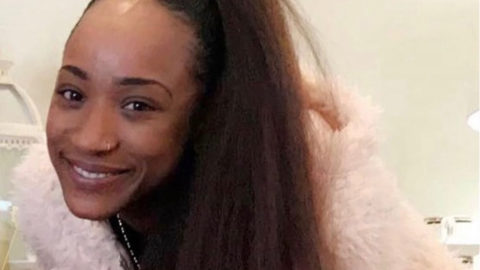SIU Clears the Toronto Police In the Death of Regis Korchinski-Paquet
Regis Korchinski-Paquet died on May 27 while Toronto police were in her home and people are understandably outraged

Trigger warning: This article contains references to Black grief, death and police violence.
Update: On August 26, Ontario’s Special Investigations Unit released a video statement saying they found no reasonable grounds to lay charges in connection to the May death of Toronto resident Regis Korchinski-Paquet under suspicious circumstances involving police. “On my review of the evidence, there are no reasonable grounds to believe that any of the officers committed a criminal offence in connection with Ms. Korchinski-Paquet’s death,” Jospeh Martino director of the SIU, said in the video. In response to the decision, members of Korchinski-Paquet’s family said they are “totally disgusted” with the outcome and believe the SIU is leaving out pertinent information.
In a time that has already been rife with death and police brutality, there’s yet another hashtag trending on Twitter. Overnight on May 27, #JusticeForRegis began picking up steam after the suspicious death of 29-year-old Regis Korchinski-Paquet, a Black and Indigenous woman in the High Park area of Toronto. And on May 30, thousands of people took to the streets of Toronto to protest the police’s involvement in her death. But now that the march is over, what do we do next?
Why was #JusticeForRegis trending?
In a series of videos posted to Instagram and Instagram stories, user @rocawrld—who identified himself as the woman’s cousin—said that his cousin had been murdered by police officers, having been pushed from her balcony. [FLARE has chosen not to share the aforementioned videos, but have linked to them for any reader who has the emotional and mental capacity to view them.]
“They killed my female cousin today a black woman,” @rocawrld captioned one of the videos. “The police [threw] her off the balcony at 100 high park Toronto, Ontario.” In the video, @rocawrld is seen standing outside of the building, cordoned off with police tape and a few officers. Visible in the background is an orange tarp, covering the victim’s body. ”Look at this, there’s no news here,” @rocawrld said. “My cousin has been on the floor [for] over an hour. The police murdered my cousin.” Later in the video he repeated: ”They killed my cousin. No remorse.”
Another video, shared to Instagram stories, featured a woman who identified herself as the victim’s mother, stating: “The police killed my daughter, came in my apartment and shoved her off the balcony.” (On May 29, Knia Singh, a lawyer who represents Korchinski-Paquet’s family, told reporters that the family “had a lot of emotion and grief” in the initial video on Wednesday, noting that the family was not in the unit at the same time as the officers. “Some concerns are being raised about the mother saying that the police threw her daughter off the balcony,” Singh said. “I can verify on behalf of the family that this was not witnessed by the mother. However, at the time of the statement, that is what the mother believed.” Regardless, he emphasized: “The mother believes that if police had acted differently, that her daughter would still be alive.”)
The SIU (Special Investigations Unit), a self-described “arms-length agency” that investigates any death, serious injury or allegation of sexual assault involving police, issued a news release around 9:45 p.m. the same day announcing that they are investigating the circumstances surrounding Korchinski-Paquet’s death, stating that Toronto Police Service officers responded to a domestic incident call at around 5:15 p.m. on May 27 at the aforementioned apartment building. According to the news release, “while officers were inside an apartment unit on the 24th floor, they observed a woman on the balcony.” And, “a short time later,” per the release, “the woman fell from the balcony to the ground below.”
The province’s Special Investigations Unit is investigating the circumstances surrounding the death of a 29-year-old woman this evening in Toronto. While police were present at an apt building on High Park Avenue, the woman fell to her death. https://t.co/o8YIJXQxQW
— SIU (@SIUOntario) May 28, 2020
In a follow-up news release issued on May 28, the SIU revealed that interviews with witnesses had begun and will be ongoing for the next few days. Addressing the comments made by the victim’s family members, the statement reads: “The SIU is aware of allegations made by certain family members of the deceased and will be looking to speak to anyone with information about these allegations. As the investigation is in the early stages, it would be inappropriate for the SIU to make any further comment at this time with respect to what transpired.”
According to Global News reporter Kamil Karamali—who spoke with the family’s lawyer on May 28—there was a fight between Korchinski-Paquet and her brother, Reese. Because Korchinski-Paquet had had a seizure before the fight, her family was concerned it would flare up again due to her fight with her brother; they called police in order to have assistance in taking Korchinski-Paquet to CAMH. Per the family, upon arrival of TPS officers, Korchinski-Pacquet was alone inside the family’s apartment with several officers after going in to use the restroom. After 1-2 minutes, her family—who was in the hallway with additional officers—heard “commotion” in the apartment and then heard Korchinski-Paquet cry out “mom, help! mom, help,” before hearing silence.
In a statement provided to FLARE by Toronto Police Service on May 28, Chief Mark Saunders said that the Toronto Police Service is “fully co-operating with the Special Investigations Unit,” stating: “Let me be very clear that we want the facts as much as anyone.” In a follow-up press conference on May 29, Saunders said police received three 9-1-1 calls about an alleged assault at the apartment that involved knives (a claim the family refutes), and implored Canadians to be patient, stating: “I request the public and communities wait for all of the facts regarding this case so that we can move forward once we establish exactly what happened that evening.”
What was the public response to the death of Regis Korchinski-Paquet?
Shortly after the video was posted to social media, users on Instagram and Twitter responded in outrage, tagging Canadian news outlets and American activist Shaun King, upset over the lack of coverage of the incident by Canadian news media (an issue that may contribute to the inaccurate perception many people have that racism is not an issue in Canada, as opposed to sensationalized coverage in the United States), and the passivity of many initial news reports, which didn’t name the victim.
Regis Korchinski-Paquet #SayHerName
— Farrah Khan (@farrahsafiakhan) May 28, 2020
And, coming on the heels of the murder of George Floyd by Minneapolis police, false reporting by a white woman against a Black man to police in New York City’s Central Park, the shooting death of Ahmaud Arbery in February, and the over-policing of Black people and their health during the COVID-19 pandemic, Korchinski-Paquet’s death is yet another tragedy for a community that has been—and continues to be—targeted, subjected to excessive force by law enforcement and killed at higher rates than other Canadians. Which is tiring.
As many people, like journalist Sadiya Ansari, have pointed out, this is hardly the first inconsistent account around the death of a Black person involving police. In the United States, the 2015 death of Sandra Bland comes to mind. Bland, who was pulled over by police for failing to signal a lane change, was arrested on a charge of assaulting a public servant. In jail awaiting her bail, Bland allegedly committed suicide. Days after her suicide, state trooper Brian C. Encina told investigators for the Department of Public Safety’s Office of Inspector General of Bland’s arrest: “My safety was in jeopardy at more than one time.” But in May 2019, footage of the encounter, filmed by Bland, was released to the public, and showed a very different exchange between Bland and the officer.
And where is the CONTEXT? The point is also this isn't the first time an inconsistent account involving a death when police are involved.
This is why people tell me they don't trust the media. It's fucking embarrassing.
— Sadiya Ansari (@SadiyaAnsari) May 28, 2020
And this also isn’t the first the SIU has been called to investigate the killing of a Black person with police involvement—to varying degrees of justice. In July 2015, the agency failed to charge a Peel region police officer for the shooting death of then-33-year-old Jermaine Carby. Carby allegedly refused to put down a knife when he was pulled over by three officers who claimed they feared for their lives. (It’s important to note that said knife was not initially found at the scene. A kitchen knife was turned over several hours later by a Peel sergeant who said an officer had bagged it after removing it from Carby’s hand as he lay on the ground after the shooting.)
On March 30, thousands of people gathered at Toronto’s Christie Pits park to march towards Toronto Police Headquarters and demand #JusticeForRegis. The peaceful rally—which was organized by Not Another Black Life—called for a transparent investigation into Korchinksi-Paquet’s death and was in response to the wider issues of anti-Black and anti-Indigenous racism.
The voice behind this speech is that of artist, activist and educator @Keoshaloveee. Learn more about the important work she does here: https://t.co/6x2LoKdF6q #JusticeForRegis https://t.co/d8RFFJIBBy
— blogTO (@blogTO) May 31, 2020
So, what should we do next?
With the march for Korchinski-Paquet over, there is still so much more that people (especially non-Black allies) can do to support Black communities, battle racism and actively promote anti-racism. Immediately, those who want to continue the work (and we should *all* want to continue the work), should reach out to their local government representatives. In the case of Korchinski-Paquet, the names and contact info of important officials, alongside an email template asking for transparency and efficiency from the inquest into her death, have been circulating online.
https://www.instagram.com/p/CAx8QP2pQUo/
It seriously takes less than 10 minutes to send a few emails and it’ll make a difference.
One of the next biggest steps? Donate. For anyone able to financially support the fight against racism—and organizations actively combatting racism on the front lines—there are many reputable organizations to donate to. Across the United States, funds and organizations to help bail those who’ve been incarcerated for protesting are available online.
In Canada, a verified GoFundMe has been been started for Regis Korchinski-Paquet by her family. Another organization doing good work is Black Live Matter Toronto, which works to dismantle all forms of anti-Black racism, liberate Blackness, support Black healing and affirm Black existence. Additional organizations include The Black Health Alliance (which improves the health and well-being of Black communities), the Prisoner Emergency Support Fund (supports incarcerated individuals in Ontario during the COVID-19 pandemic) and the COVID-19 Black Emergency Support Fund (a fund for Black people in the Greater Toronto Area who need extra support during the pandemic).
https://www.instagram.com/p/CA04VKDAyjb/
In addition to donating to these (and other) organizations, we can support Black-owned businesses and brands. And for people who are unable to donate or purchase from Black-owned businesses, education and discussion is key. Read up on anti-racism and racism and the experience of Black communities both north and south of the border as a way to begin interrogating your own privilege. Have these conversations with people in your community (especially non-Black people). And most importantly: do not ask or expect your Black friends, co-workers or neighbours to educate you on what’s going on and why it’s wrong. There are endless resources available online now to help you become more informed and learn to better support the people in your life who are actively being harmed.
Good morning, Friday fam. ICYMI, we have a list of things non-Black POC, Indigenous people and white people can do *right now* to support our Black loved ones. #BlackLivesMatter https://t.co/9nIsbarLAI
— Friday Things (@fridaythings) June 1, 2020
Finally: Don’t stop paying attention and discussing the systemic racism and anti-Blackness that plagues our society, beyond the protests and this current news cycle. Black individuals don’t have the luxury of turning off the TV and turning away from the treatment of Black bodies, so non-Black people shouldn’t either.
FLARE has reached out to the SIU and @rocawrld for comment. The article will be updated with their responses.









